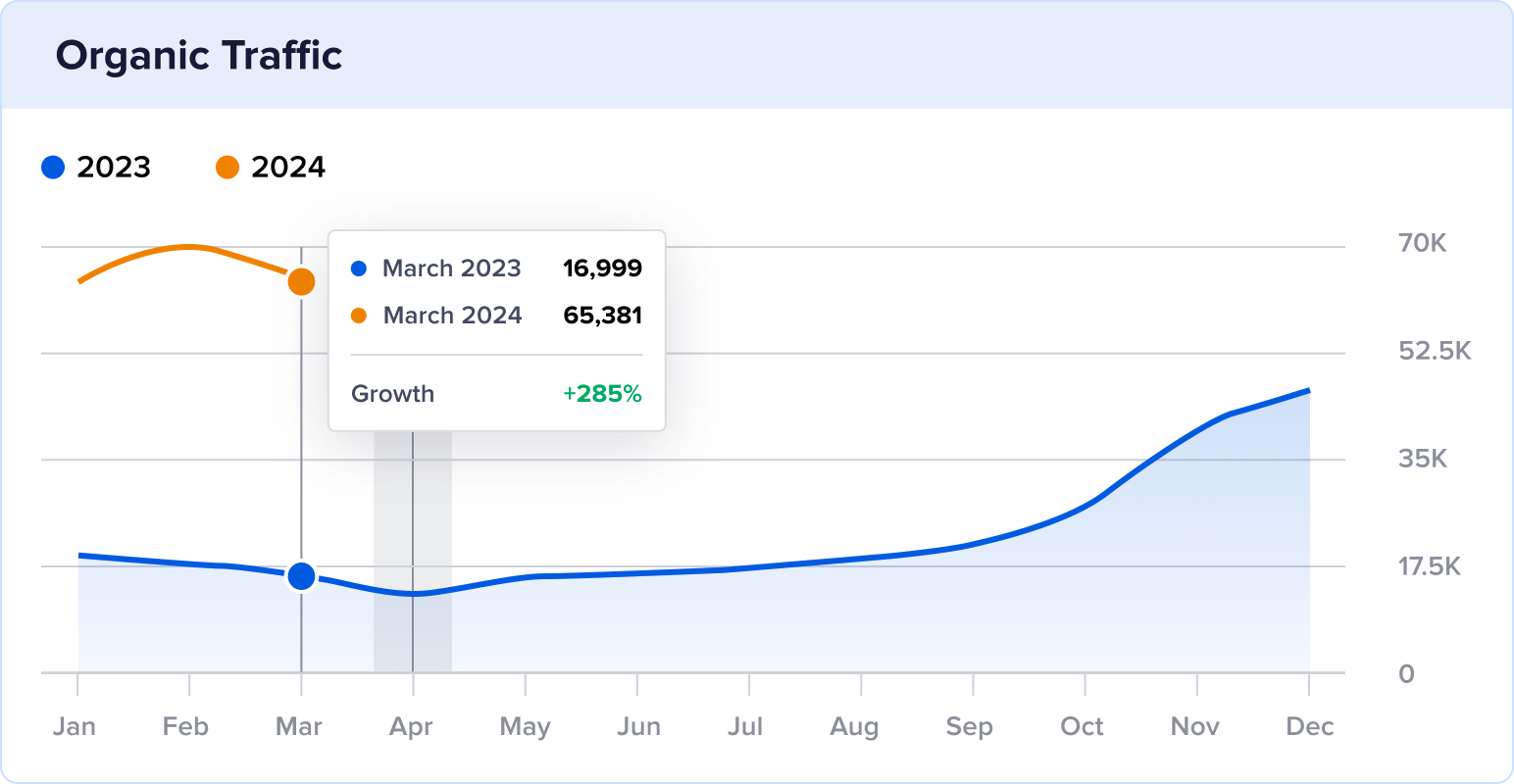How an Eco-Conscious Bedding Manufacturer Grew Traffic by 775% YoY
https://barehome.com/
Stats
5.6K to 48.9K Monthly Visits
Industry
Ecommerce & Retail
Niche
Textiles
Reporting Date
January 2024
In 2008, a small business emerged with a big dream—to offer bedding free from harmful chemical substances at an affordable price.
Fast forward to today, and Bare Home is not only a leader in the eco-conscious bedding sector but has also unlocked its most significant digital milestone yet—775% year-over-year (YoY) traffic growth.
Join us as we peel back the layers of this SEO success story, uncovering the strategies that propelled Bare Home to unprecedented heights. Plus, get tips and tools for implementing these winning strategies on your site.
In This Article
About Bare Home
Josh Pribyl founded Bare Home in 2008.
Frustrated by the lack of options and exorbitant prices for chemical-free bedding, Pribyl set off to make his own solution.
Bare Home was born, providing eco-conscious customers with affordable, high-quality bedding free from harmful substances.

Today, Bare Home is an online-only retailer that sells in the United States, United Kingdom, and Canada.
Customers can also shop their line of products at popular retailers like Wayfair, Target, and Amazon.
Historical Performance
According to Semrush historical data, barehomes.com started receiving traffic in June 2017.
Traffic was slow to start, averaging 400 monthly visits for the first 2 years.
Then, 2020–2022 brought its first wave of growth. Monthly traffic averaged 4.8K visits during this time.

But it wasn’t until Q4 of 2023 that Bare Homes started to show promise like never before.
In October, they reached 12.7K visits—their highest record up to that point.
The following months then blew this traffic out of the water, growing by 284% by January.
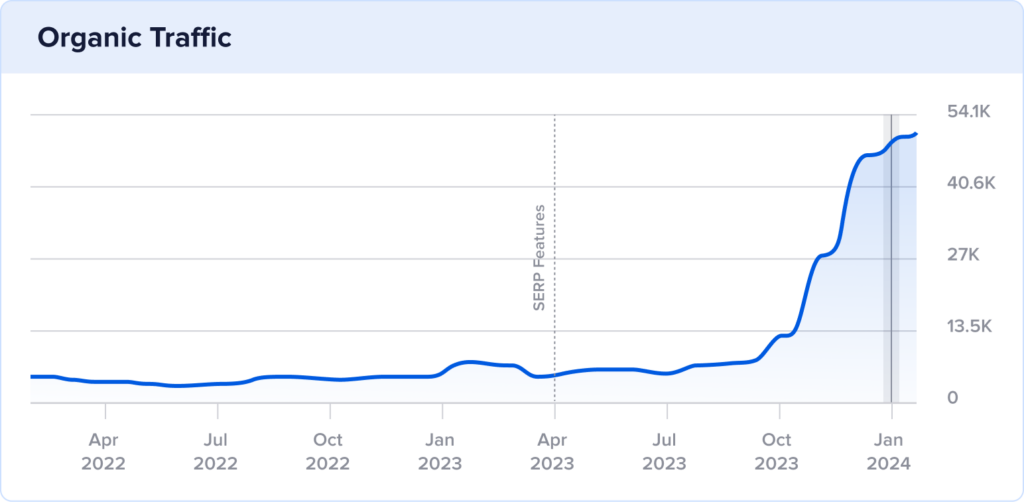
So, what triggered this unprecedented leap to 48.9K organic visits?
And are these strategies replicable on your website?
Let’s find out.
The Catalyst: How Bare Home Achieved 775% Growth YoY
Barehome.com grew its organic traffic by performing the following:
- Implementing product review schema markup
- Optimizing images to rank in search results
- Building out its product catalog and collections
1. Implementing Product Review Schema Markup
In mid-2023, Bare Home started using product schema markup on its website.
Product schema is code that lives in the HTML of a web page. It communicates important product details, like price and availability, to search engines.
Furthermore, you can include additional elements like customer ratings and reviews.
Ultimately, the goal of product schema is to win a rich snippet on the search engine results page (SERP). (And while not guaranteed, schema markup is one of the best ways to get them.)
There are various types of rich results, but the example below shows a product review snippet.

Schema markup helped Bare Home win a rich result that shows an image, a 5-star rating, and the price.
Compared to a non-rich result on the same page, which one would you click?

Why this matters:
Most users are inclined to click search results that take up more space on the SERP and display more information.
And ranking statistics prove it.
Rich snippets, or rich results, get 58% of all clicks. This is significantly higher than non-rich results, which have a 41% clickthrough rate (CTR).
For Bare Home, the recent implementation of product review schema proved pivotal in its online presence and organic traffic.
They went from having 0 review snippets to 10.9K in January. These review snippets contributed an incredible 75% of all U.S. traffic for the month.

How to add product review schema on your site:
This tutorial shows you how to add product review schema in WordPress. It’s actually quite easy when you have the right tools (we’ll recommend one next).
If you don’t use plugins, you can follow this guide on manually implementing schema markup. You’ll learn three different methods, and each uses JSON-LD coding language.
Tools for product review schema:
Unfamiliar with JSON-LD? Or just want an easy way to get product review schema on your site?
A schema generator plugin is an invaluable tool for implementing schema markup hassle-free.
All in One SEO (AIOSEO) offers a user-friendly Schema Catalog, where adding schema markup is as easy as a click of a button.
For product schema, simply select Product from the catalog, and we’ll format the structured data for Google.
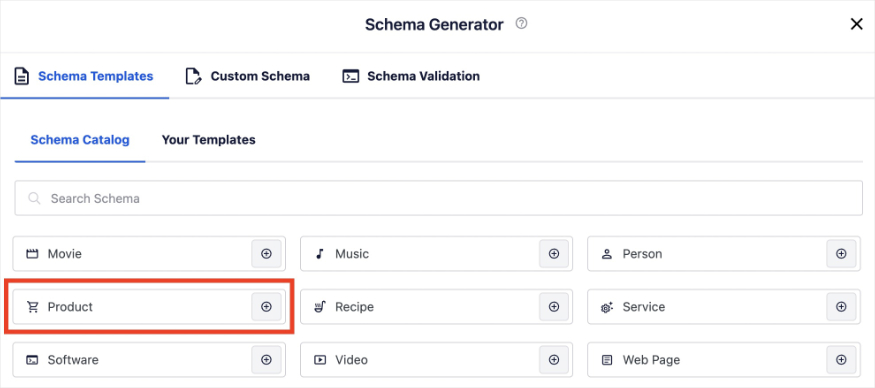
Then, we’ll walk you through setting important product details, like the price or special offers.
You can also add reviews, as shown below, and we’ll format the product review schema for search engines.
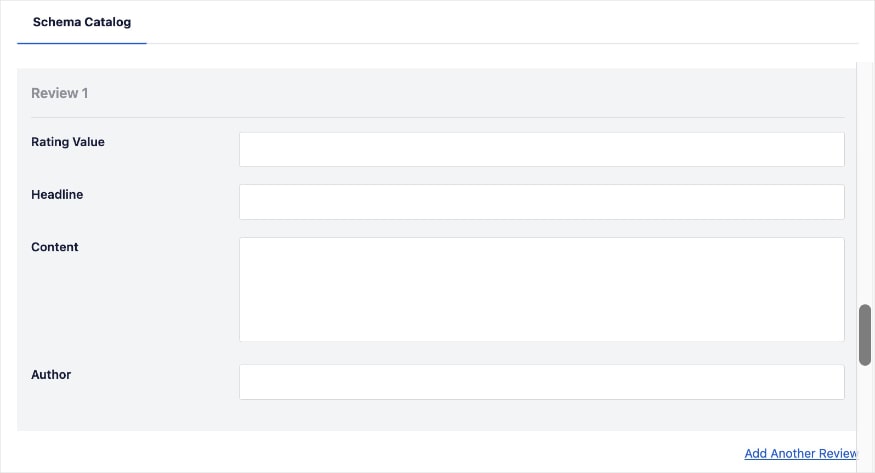
Next, let’s look at how schema markup and a dash of image SEO skyrocketed another type of rich results.
2. Optimizing Images to Rank in Search Results
What’s great about product schema markup is that you can also point search engines to a specific image of the product.
And with Bare Home’s recent implementation of product schema, they did just that.
Every product page we checked had an image assigned to it in the schema markup.
Let’s look at an example.
Here’s a product detail page (PDP) for a polar fleece blanket:

When we look at the web page’s schema, we see the URL for an uploaded image. (This URL opens the image of the grey blanket we see above.)
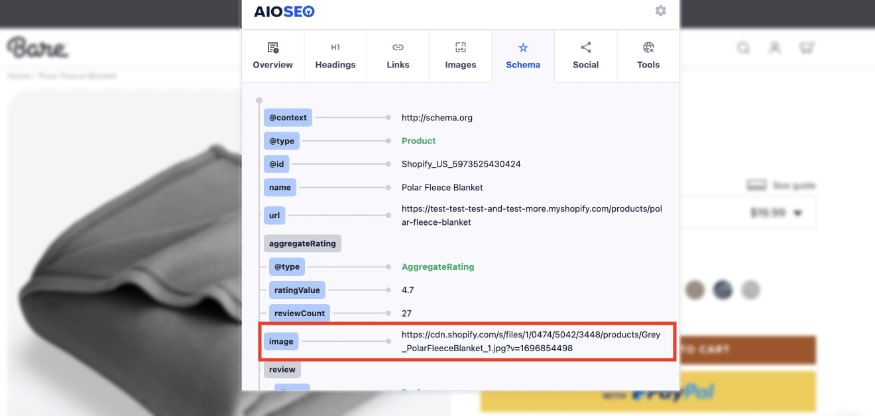
Note: The above screenshot was taken from the All in One SEO Analyzer. This free Chrome Extension makes it easy to analyze competitors’ websites or your own.
Now, here’s where we get to the good stuff.
Not only do we see this image in the review snippet, as shown below, but we also find it ranking in Google Images.
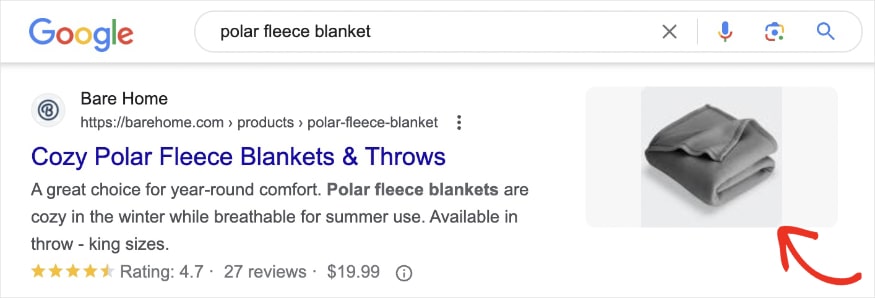
Bare Home is the third result in Google Images search results, albeit with a slightly different picture.
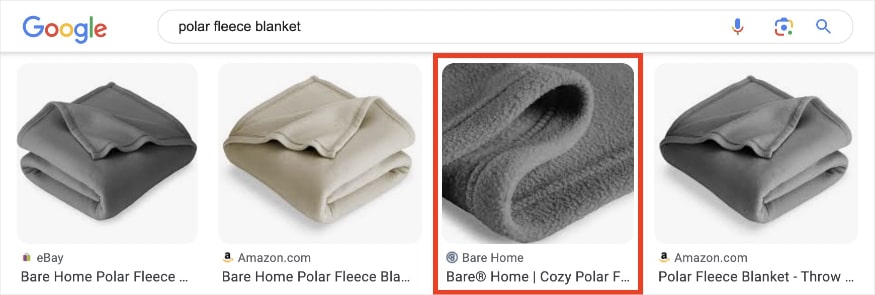
It’s important to keep in mind that just because you use schema markup or set an image in it doesn’t mean Google will (1) generate a rich snippet) nor (2) use the image provided.
Ultimately, Google serves search results based on a per-search basis. This means it can change how it looks depending on the user and search.
With that said, setting these parameters in your web pages is considered an SEO best practice and increases the likelihood of Google using your settings.
Why this matters:
There are approximately 1 billion Google image searches every day. And every search is an opportunity to drive traffic to your site.
While it’s easy to overlook the details when building out your website, it’s important to remember that the best SEO strategies are holistic. Optimizing your images is equally important as writing strong copy to go with it.
In Bare Home’s case, these efforts proved fruitful. In addition to ranking in Google Images, they also earned 5.9K keyword rankings in January on the traditional search with image rich results.
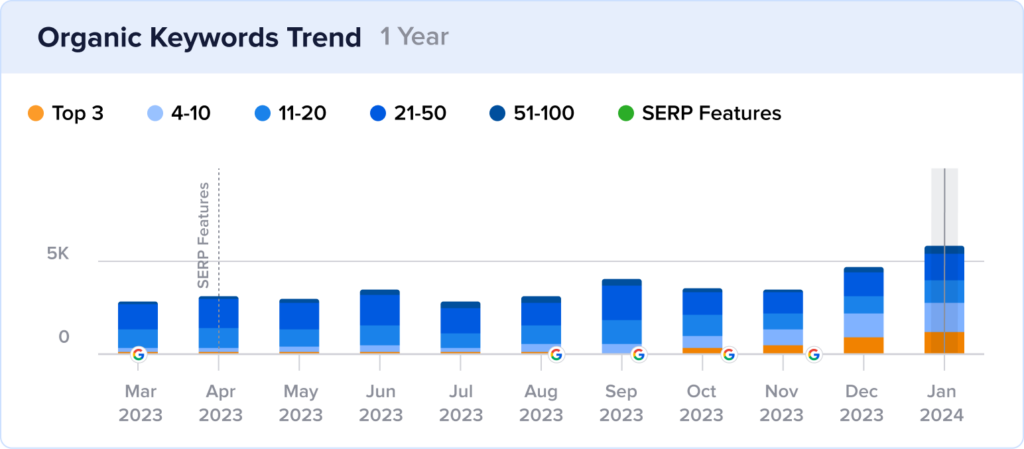
How to optimize images on your site:
Follow Bare Home’s lead and upload images in your product schema markup. You’ll also want to follow other image SEO best practices, like using your keyword in certain image elements.
For example, Bare Home optimizes the image file name (in blue) and alt text (in black) with its primary keyword (polar fleece blanket).
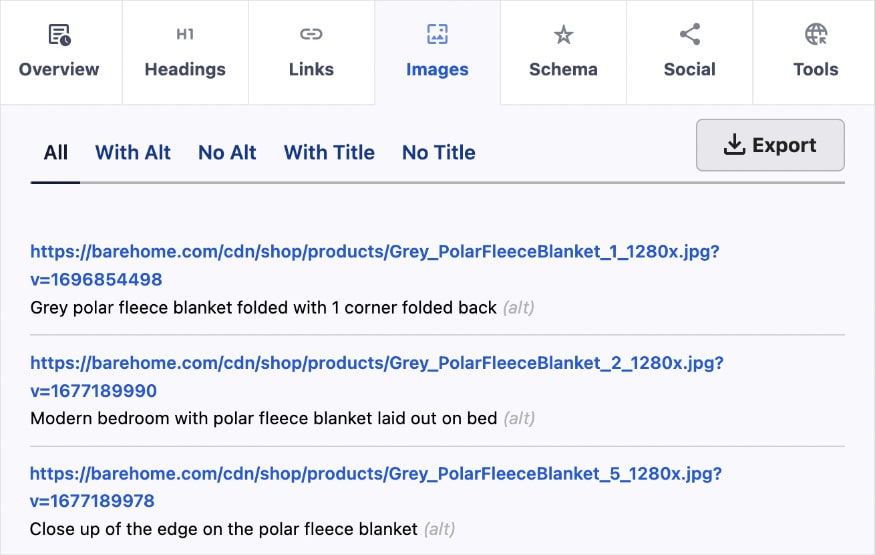
You’ll also want to pay attention to elements like:
- File size
- Image dimensions
- Captions
For a full list of items, our image SEO tutorial shows you where and how to optimize for each.
Tools for image SEO:
Image SEO can be labor-intensive when you have a lot of graphics on your site.
Luckily, certain tools streamline these optimizations.
The Image SEO feature in AIOSEO allows you to automate writing image titles, alt tags, and more.

As for adding images to your product schema, it couldn’t be easier. Simply select Product from the Schema Catalog and upload your image. That’s it!

Next, let’s see how Bare Home maintains its website for content freshness.
3. Building Out Its Product Catalog and Collections
Between January 2023 and January 2024, Bare Home added around 70 new pages to its website.
These additions brought the total page count to around 180 URLs.
And while they haven’t been a huge traffic driver yet, they have impacted Bare Home’s keyword rankings.
In January 2024, Bare Home doubled its rankings over the previous year.

Why this matters:
While it’s common to see product turnover at eCommerce businesses, there are a few noteworthy mentions regarding keeping your site up to date.
- Search engines love fresh content. Fresh content refers to new or updated content. Keeping your site current sends signals to search engines that your content is relevant to today’s search landscape, potentially boosting rankings.
- The more content you have, the wider the net for keyword rankings. As we saw with Bare Home, increasing the page count by two-fold doubled its rankings. It’s simple: the more attempts you make to rank, the greater your chances of success.
How to target new keywords on your site:
Finding new keywords to target starts with keyword research.
Keyword research is the process of analyzing what users are looking for in search engines. It reveals topics that resonate with your target audience, allowing you to tailor content to their needs and interests.
For a tutorial, this keyword research guide shows you how to do it using popular SEO tools.
Once you’ve collected a list of keywords, use them as the foundation for your content strategy. Topic clusters can help you with this process.
Topic clusters offer a framework for organizing your keywords. They’re easy to learn how to use and will keep you on track as you build out your content.
Tools for keyword research:
Did you know that you can do keyword research in WordPress?
AIOSEO’s Keyphrase Suggestions tool makes this possible by connecting to your Semrush account. It fetches relevant terms to your focus keyword and presents them directly in the WordPress editor.

You can also check out this lineup of the best keyword research tools for recommendations outside of WordPress.
Standout SEO Wins
Before we conclude, there’s an additional technique we’d like to highlight at Bare Home.
1. They have a blog, “Beyond Bedding.”
In the world of eCommerce, maintaining a blog can be a powerful way to connect with your audience at every stage of the buyer’s journey. Catering to informational needs allows you to reach a wider audience, thus boosting brand awareness. It also helps you establish niche authority and credibility in the eyes of both users and search engines. Ultimately, a blog can set you apart from competitors and solidify your brand’s position as a trusted source.
Tip: Data shows that 56% of users make a purchase after reading the company’s blog.

Tool: You can streamline content optimizations with the TruSEO Analysis tool. TruSEO gives you actionable checklists to maximize your content’s reach.
Here’s an example of the Focus Keyphrase Checklist:

Takeaways
In our analysis of barehome.com, we’ve discovered what unlocked their recent SEO success.
Now, let’s recap which strategies to implement on your website and others to reconsider.
Top 3 Strategies to Emulate
- Harness the power of product schema for review snippets. Using product schema markup on your eCommerce site can help you secure coveted review snippets in search results. Review snippets are an excellent way to increase your visibility on the SERP and build trust with potential customers.
- Optimize for Google Images with image SEO. With over 1 billion searches on Google Images daily, image SEO is integral to maximizing your traffic. Image SEO involves optimizing image file names, alt text, captions, and more. It provides additional context for users while making it easier for search engines to understand your image, potentially increasing rankings.
- Maintain content freshness for enhanced visibility. Regularly adding or updating content on your website can help it maintain its freshness. Fresh content signals to search engines that your site is active and relevant. It can attract more frequent indexing by crawlers, leading to improved rankings and visibility in search results.
Bottom 3 Strategies to Reconsider
- Omitting author bios on blog posts. Neglecting to include author bios can undermine credibility and diminish user engagement. Author bios provide readers with information about the writer’s experience and expertise, fostering authority and trust. These elements of Google E-E-A-T will be invaluable in 2024 and crucial for ranking. Plus, author bios are easier to include than ever with WordPress tools like Author SEO.
- Overlooking image title tags. Ignoring image title tags deprives your users of valuable context. Image titles appear when readers click or hover over an image. In addition to providing more information, they also help search engines more easily understand your image. You can use smart tags in the Image SEO feature, which allows you to customize and automate writing them.
- Missing meta descriptions on some pages. Failing to include meta descriptions can result in low clickthrough rates (CTR). Meta descriptions are a valuable opportunity to entice users and drive traffic to your site. By crafting compelling meta descriptions for every indexable page, you can improve your CTR and grow organic traffic. You can even use a meta description generator to write them for you.
Steal Our Winning SEO Strategy: A Checklist for Your Website
Do you want to grow your website’s visibility and organic traffic?
Our SEO Checklist has you covered with everything you need to rank at the top of search results.
Download A Free SEO Checklist
Access our comprehensive SEO Checklist with a single click. We’ll deliver it straight to you, putting actionable items with SEO tools and tutorials right at your fingertips.
Enter your name and email to download a free SEO checklist.
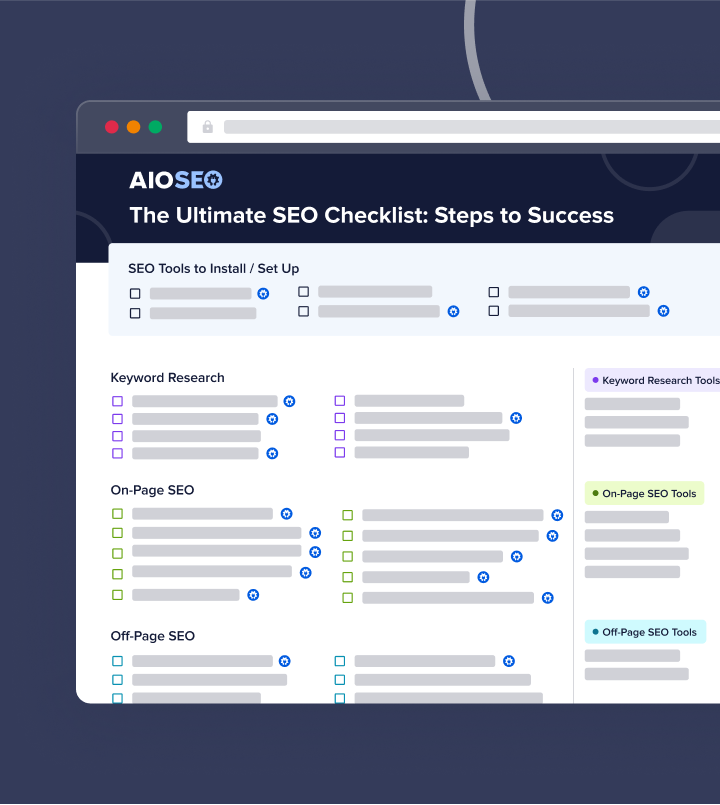
Boost Your Rankings and Grow Your Business With AIOSEO
You don’t have to tackle a winning SEO strategy alone.
Let All in One SEO (AIOSEO) do the heavy lifting for you so you can focus on what matters most: growing your business.
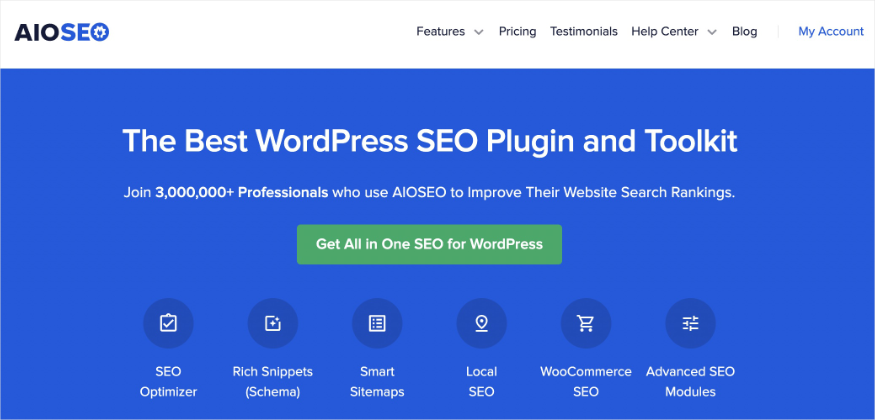
AIOSEO is the best WordPress SEO plugin on the market, and you don’t just have to take our word for it. With thousands of 5-star reviews and trusted by over 3 million website owners, AIOSEO is your all-inclusive tool to elevate your website’s visibility and drive organic traffic.
Here are a few of our favorite features:
- Rich Snippets Schema: AIOSEO offers various schema markups to help you claim more rich results on the SERP. It’s as simple as choosing the schema you want; then, we’ll format the structured data for Google.
- Image SEO: Turn on automatic image alt text and title attributes with a single click. You’ll save time from manual entries while helping users and search engines understand your images.
- Semrush Keyphrase Suggestions: Perform keyword research directly in the WordPress editor. AIOSEO connects with your Semrush account to generate and serve keyword ideas for your content.
- TruSEO Score: Get a snapshot view, or go into detail, of your content’s on-page SEO with this innovative tool. TruSEO analyzes your content and gives you actionable insights to maximize its reach.
- Author SEO: Create engaging author bios that showcase your experience and expertise. This addon aligns your content with Google E-E-A-T guidelines and helps establish trust with readers.
- AI Title & Description Generator: This time-saving tool creates compelling metadata for any page on your site. With the click of a button, you’ll harness the power of AI and get options for unique meta titles and descriptions.





